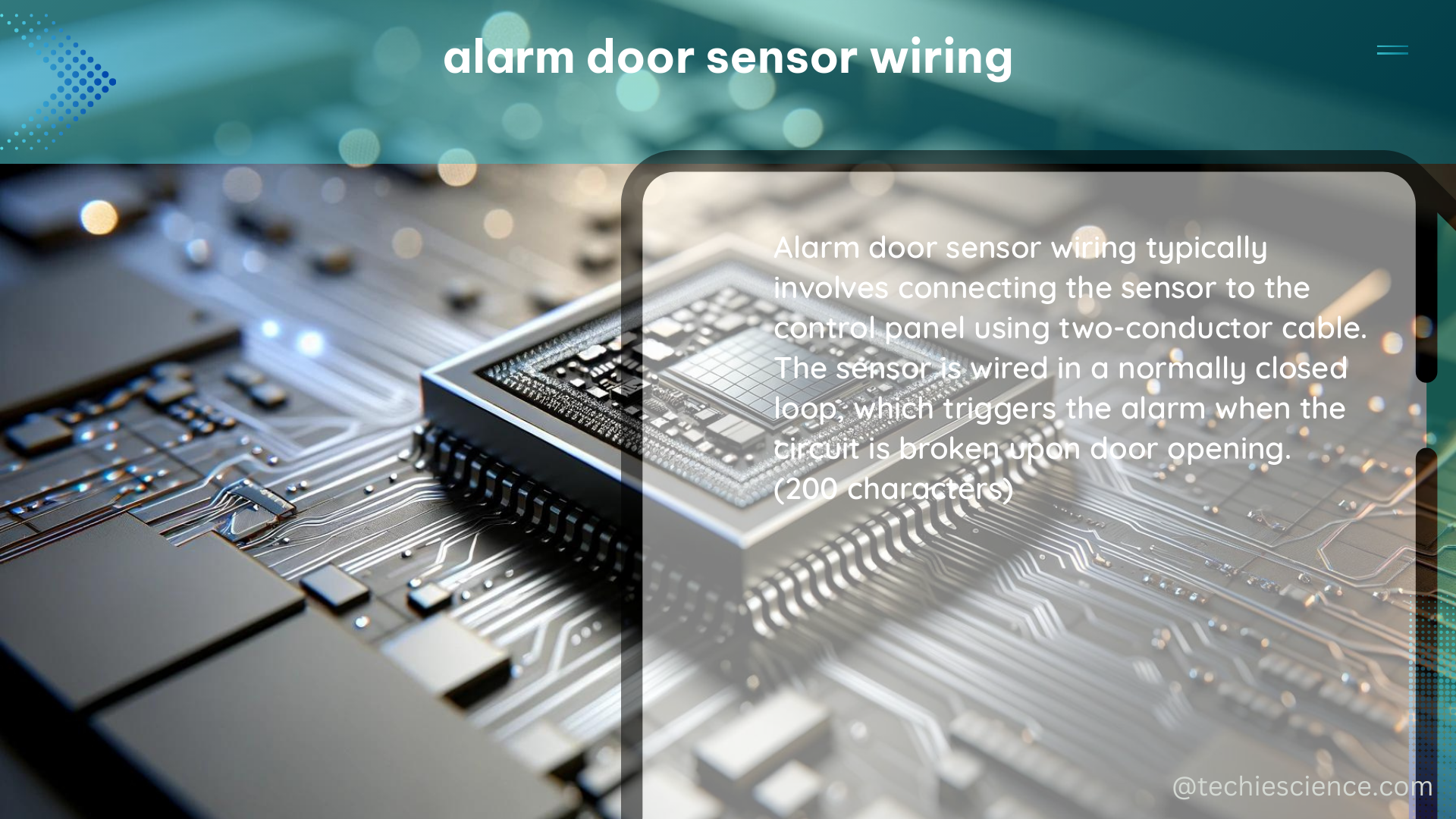Alarm door sensor wiring is a critical component of any security system, ensuring the reliable detection and communication of door openings to the alarm control center. This comprehensive guide delves into the technical specifications, testing procedures, and best practices for alarm door sensor wiring, providing a valuable resource for DIY enthusiasts and security professionals alike.
Shielded Wiring for Electromagnetic Interference Protection
The technical specifications for alarm door sensor wiring dictate the use of shielded wiring, such as Mumetal or steel, to protect against electromagnetic interference (EMI) and ensure reliable communication between the sensor and the alarm system. Mumetal, a nickel-iron alloy, is highly effective in shielding against low-frequency magnetic fields, while steel provides protection against both low-frequency and high-frequency electromagnetic fields.
The shielded wiring should be installed in a conduit from the sensor switch enclosure to the alarm data-gathering or multiplexer panel, further enhancing the protection against external interference and physical tampering.
Balanced Magnetic Switch (BMS) Wiring for Door and Window Protection

When wiring a balanced magnetic switch (BMS) for door and window protection, the sensor electronics enclosures must have tamper switches installed. These tamper switches are designed to detect any unauthorized access or tampering with the sensor enclosure, triggering an immediate alarm.
Additionally, line supervision should be used to monitor the communication link between the sensor and the alarm control center. This feature helps protect against adversary attacks on the communication links and sensor electronics enclosures, ensuring the integrity of the alarm system.
Alarm Communication Timing and Sensor Sensitivity Testing
The NUREG-1959 report, a comprehensive guide on intrusion detection systems and subsystems, provides specific guidelines for alarm communication and sensor system testing.
According to the report, alarms should be communicated to the alarm station operator within 2 seconds of sensor activation. This stringent requirement ensures that the alarm system can respond quickly to any detected intrusion, minimizing the potential for unauthorized access.
To verify the uniform sensitivity of the sensor system, the report recommends testing at or near the anchor post and within approximately 10 feet of the sensor. This testing procedure helps ensure that the sensor is capable of detecting intrusions across the entire protected area.
The ladder test, another recommended procedure, involves an individual placing a ladder against the wires and climbing the ladder to a point where sensor activation occurs. This test helps assess the sensor’s ability to detect vertical movement, a common tactic used by intruders.
The wire deflection test, on the other hand, measures the distance that each wire can be moved before an alarm occurs. This test provides valuable insights into the sensor’s sensitivity and ability to detect lateral movement.
Evaluating Interior Sensors for Optimal Performance
When evaluating interior sensors, the goal is to determine how well the installed devices will perform against the expected threat. This evaluation process considers several key factors:
-
Principle of Operation: Understanding the underlying principle of operation for the sensor, such as passive infrared (PIR), microwave, or dual-technology sensors, is crucial in assessing its suitability for the specific application.
-
Operating Environment: Analyzing the sensor’s operating environment, including factors like temperature, humidity, and potential sources of interference, helps ensure optimal performance and minimize the risk of false alarms.
-
Installation and Interconnection: Proper installation and interconnection of the sensor equipment, including wiring, power supply, and integration with the alarm system, are essential for reliable operation.
-
Nuisance Alarm Rate (NAR): Evaluating the sensor’s nuisance alarm rate, which measures the frequency of false alarms, helps determine the overall effectiveness and reliability of the system.
-
Maintenance: Establishing a comprehensive maintenance plan, including regular inspections, cleaning, and calibration, ensures the sensor system remains in optimal condition over time.
-
Defined Threat: Understanding the specific threats the sensor system is designed to address, such as unauthorized entry, vandalism, or theft, helps in selecting the appropriate sensor technology and configuration.
By considering these factors, security professionals can make informed decisions about the selection, installation, and maintenance of interior sensors, ensuring the alarm door sensor wiring system performs at its best against the expected threat.
Conclusion
Alarm door sensor wiring is a critical component of any comprehensive security system, requiring careful attention to technical specifications, testing procedures, and best practices. This guide has provided a detailed overview of the key considerations, including the use of shielded wiring, tamper switches, line supervision, and sensor sensitivity testing, to ensure the reliable and effective operation of alarm door sensor systems.
By following the guidelines and recommendations outlined in this comprehensive guide, DIY enthusiasts and security professionals can ensure their alarm door sensor wiring systems are designed, installed, and maintained to the highest standards, providing robust protection against unauthorized access and intrusion.
Reference:
- NUREG-1959 “Intrusion Detection Systems and Subsystems”
https://www.nrc.gov/docs/ML1111/ML11112A009.pdf - NUREG-1959, Rev. 01, “Intrusion Detection Systems and Subsystems”
https://www.nrc.gov/docs/ML1725/ML17250A867.pdf - Effective Physical Security – NIBM E-Library Portal
https://nibmehub.com/opac-service/pdf/read/Effective%20Physical%20Security%20by%20Fennelly-%20L.J.%205ed.pdf

The lambdageeks.com Core SME Team is a group of experienced subject matter experts from diverse scientific and technical fields including Physics, Chemistry, Technology,Electronics & Electrical Engineering, Automotive, Mechanical Engineering. Our team collaborates to create high-quality, well-researched articles on a wide range of science and technology topics for the lambdageeks.com website.
All Our Senior SME are having more than 7 Years of experience in the respective fields . They are either Working Industry Professionals or assocaited With different Universities. Refer Our Authors Page to get to know About our Core SMEs.